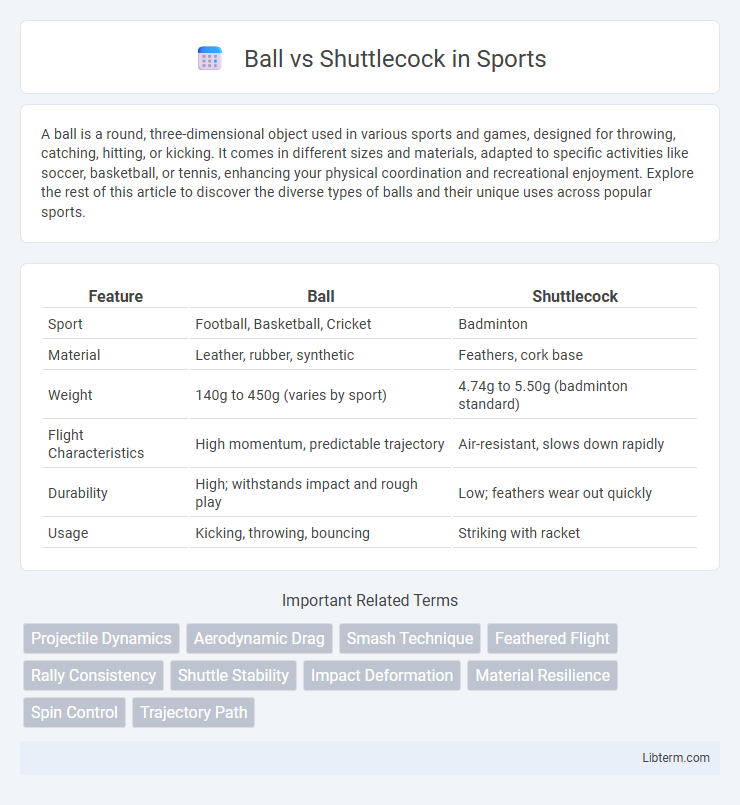A ball is a round, three-dimensional object used in various sports and games, designed for throwing, catching, hitting, or kicking. It comes in different sizes and materials, adapted to specific activities like soccer, basketball, or tennis, enhancing your physical coordination and recreational enjoyment. Explore the rest of this article to discover the diverse types of balls and their unique uses across popular sports.
Table of Comparison
| Feature | Ball | Shuttlecock |
|---|---|---|
| Sport | Football, Basketball, Cricket | Badminton |
| Material | Leather, rubber, synthetic | Feathers, cork base |
| Weight | 140g to 450g (varies by sport) | 4.74g to 5.50g (badminton standard) |
| Flight Characteristics | High momentum, predictable trajectory | Air-resistant, slows down rapidly |
| Durability | High; withstands impact and rough play | Low; feathers wear out quickly |
| Usage | Kicking, throwing, bouncing | Striking with racket |
Introduction to Ball and Shuttlecock
Balls are spherical objects commonly used in sports such as soccer, basketball, and tennis, characterized by their material composition, size, and weight specific to each game. Shuttlecocks, also known as birdies, are feathered projectiles used exclusively in badminton, designed with a conical shape and a cork base to optimize aerodynamic flight. Both ball and shuttlecock serve as central equipment in their respective sports, influencing gameplay dynamics and player techniques.
Key Differences Between Ball and Shuttlecock
Balls are typically solid or hollow spheres made from rubber, leather, or plastic, designed for sports like basketball, soccer, and tennis, characterized by their uniform weight and bounce. Shuttlecocks, used primarily in badminton, consist of a conical shape with a cork base and overlapping feathers or synthetic materials, creating unique aerodynamic properties and slow flight patterns. Key differences include the material composition, flight dynamics, weight distribution, and the impact on gameplay speed and control.
Historical Origins of Ball and Shuttlecock Sports
Ball and shuttlecock sports trace their origins to ancient civilizations with evidence of ball games found in Mesopotamia and Egypt dating back over 5,000 years. Shuttlecock games, including early forms of badminton, evolved from traditional Asian games like the Chinese "Ti Jian Zi" and the Indian "Poona" during the 18th and 19th centuries. Both sports developed unique cultural significance and global appeal, adapting over centuries into modern competitive forms featured in international tournaments and the Olympic Games.
Material Composition and Design
Balls are typically composed of materials such as rubber, leather, or synthetic polymers, designed to provide durability and consistent bounce, with variations depending on the sport (e.g., basketball or tennis). Shuttlecocks consist primarily of lightweight materials like feathers or nylon attached to a cork base, engineered to create aerodynamic drag for controlled flight and stability during play. The design differences reflect their functional roles: balls require resilience and impact absorption, while shuttlecocks emphasize flight control and precision.
Aerodynamics: Flight Patterns Compared
The ball exhibits stable, predictable flight patterns due to its consistent spherical shape and higher mass, resulting in less air resistance and slower deceleration. Shuttlecocks experience rapid deceleration and highly variable trajectories caused by their conical shape and feathered skirt, generating increased drag and turbulence. These aerodynamic differences dictate strategic gameplay, with balls favoring sustained, linear motion and shuttlecocks requiring acute control and timing adjustments to manage their erratic flight.
Popular Sports Using Balls vs Shuttlecocks
Popular sports using balls include soccer, basketball, and tennis, where the spherical shape facilitates rolling and bouncing dynamics essential for gameplay. In contrast, shuttlecock sports like badminton emphasize lightweight, aerodynamic projectiles designed for rapid, precise flight and shuttle speed control. The distinct physical properties of balls and shuttlecocks influence sport strategies, equipment design, and athlete training techniques.
Skill Sets Required for Each Equipment
Ball sports demand precision hand-eye coordination, quick reflexes, and strong throwing or hitting technique to control speed and trajectory effectively. Shuttlecock games emphasize agility, rapid footwork, and wrist flicks for precise and controlled shots, requiring excellent endurance and spatial awareness. Mastery of ball equipment relies on power and timing, while shuttlecock skills focus more on finesse and rapid directional changes.
Impact on Game Speed and Strategy
The impact of ball versus shuttlecock on game speed and strategy is significant, as the shuttlecock's aerodynamic drag causes slower speeds and longer rally durations compared to the faster, more consistent bounce of a ball. Shuttlecock games demand precise shot placement, rapid reflexes, and endurance, while ball games often emphasize power, spin, and quick transitions. Understanding these differences helps players optimize their tactics, whether exploiting the shuttlecock's deceleration for strategic drop shots or using the ball's momentum for aggressive plays.
Injury Risks: Ball vs Shuttlecock Sports
Ball sports such as soccer and basketball present higher injury risks due to the increased impact force and fast-paced body contact during play. Shuttlecock sports like badminton generally involve rapid directional changes and repetitive overhead motions, leading to overuse injuries such as shoulder and wrist strains. Protective equipment and proper technique significantly reduce injury incidence in both ball and shuttlecock sports.
Choosing the Right Equipment for Your Game
Selecting the right equipment for your game depends on the playing surface, skill level, and game speed. Balls offer consistency and durability for outdoor games like tennis and soccer, while shuttlecocks provide distinct flight patterns and control suited for badminton. Understanding these differences ensures better performance and an enjoyable playing experience.
Ball Infographic

 libterm.com
libterm.com